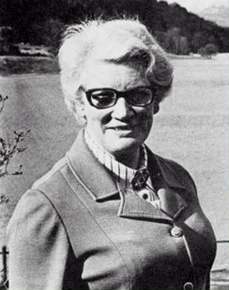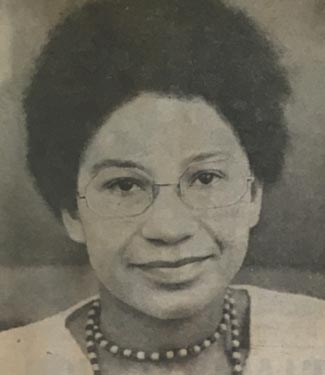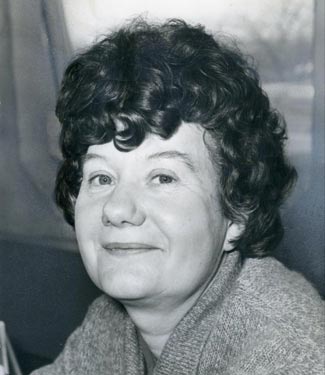The women making history at the University of Leicester: past and present
As part of our 100 Years of Change centenary celebrations we've reflected on how our history may impact our future. For this piece we looked at the role of women at Leicester from our foundation to modern day pioneers.
Turi King, Professor of Public Engagement and Genetics at the University of Leicester, made history in 2013 when she stepped up to the microphone and announced to the world’s press the discovery of Richard III’s remains under a car park. She described the experience to journalists watching from her home country of Canada as “a dream”.
But that dig was also significant for Professor King in other ways: it marked the beginning of professional partnerships with the other women on the case, like Jo Appleby, an osteologist, and Sarah Hainsworth, a forensic engineer, after they were part of a team that took turns to sit in a room as a CT scanner analysed the cuts on Richard III’s skull. Those partnerships endure to this day.
Standing up in front of the world’s press and giving the results – that was quite an extraordinary moment. But so was being with an extraordinary team of people. They are like family now.
“Standing up in front of the world’s press and giving the results – that was quite an extraordinary moment. But so was being with an extraordinary team of people. They are like family now,” Professor King says. “What I loved about the Richard III case is that the scientific analysis, the osteology, the forensics, the genetics, were all led by women.”
We reach Professor King in Scotland, where she is on location filming a new television series. She has become well-known for her work on DNA Family Secrets, a 2021 series on BBC Two that uses DNA technology to solve family mysteries around ancestry, missing relatives and genetic disease.
The series was so popular, it was recommissioned with the second series due out in a few weeks. Turi was first drawn to Leicester because of its reputation: DNA fingerprinting, a technique that allows people to be identified using their DNA, was discovered at the university by Professor Sir Alec Jeffreys, a British geneticist. As part of her role in public engagement, in 2020, Professor King brought all the individuals from the first cases to use DNA fingerprinting to the University to celebrate the 35th anniversary of the publication of Sir Alec’s paper, including solved cases in immigration, rape and murder. “It’s one of the biggest discoveries of the last century,” Professor King says. “Not only in forensics, but also in conservation and in medicine.”
Pioneering female scientists
The history of the University of Leicester is peppered with fascinating women academics like Professor King, but its record is especially strong in the sciences. The first science staff were women: Charlotte Measham taught botany in 1921, when the University College opened. She helped lay out the University's first botanical garden. The following year, Dr Ethel Miles Thomas took a permanent lectureship at the University, where she would found the botany labs. During her 14 years at the University, Dr Thomas established the teaching of biological sciences. When she retired in 1937 there were eight botany students and a researcher, plus seven zoology students.
Two lecturers replaced Dr Thomas. One of these was Anne Hosker, then Head of Zoology, to whom a young David Attenborough sold newts he caught when pond-dipping in the University grounds for the princely sum of three pence each. Sir David and his brother Richard lived on campus at the University of Leicester from 1932 after their father, Frederick Attenborough, became Principal of the University.

Professor Winifred Tutin
Indeed, between 1921 and 1957 it was common to find women at the University in the Botany and Zoology Departments, while geography remains an area of particular specialism. Generations of environmental scientists owe a debt to Professor Winifred Tutin.
Professor Tutin, who wrote under her maiden name of Pennington, joined the University of Leicester in 1947 as a demonstrator and lecturer, and became an Honorary Professor in 1980. She is regarded as a pioneer of palaeolimnology, the study of the past environments of inland waters, and palaeoecology, the ecology of the past. If you asked her, however, she would say she only studied lake or ecological history.
Professor Pennington was one of my most important mentors as a young scientist. Her pioneering studies of sediment cores from lakes in the English Lake District played an important role in the development of palaeoecological science in the UK.
Her legacy far exceeds her own modest assessment of her talents, however. “Professor Pennington was one of my most important mentors as a young scientist,” Professor Rick Battarbee, Emeritus Professor of Environmental Change at UCL, once said. “Her pioneering studies of sediment cores from lakes in the English Lake District played an important role in the development of palaeoecological science in the UK.”
The role models of today
Today, the University continues to be home to famous geographers and natural scientists, including Professor Sarah Davies, Pro-Vice-Chancellor and Head of the College of Science and Engineering. Professor Davies is an internationally renowned sedimentologist. Since 2009, she has also managed a team of researchers and technicians based at Leicester and Montpellier, France, called the European Consortium for Ocean Research Drilling, delivering scientific expeditions for the International Ocean Discovery Program. “Some of my proudest moments are when we have planned a successful expedition to ice-covered waters or environmentally shallow waters,” she says. “At one point it was an all-women team. Now it’s a bit more balanced and we have some strong women from Leicester and Montpellier.”
Professor Davies was once an undergraduate student at Leicester studying geological sciences, on a course where only 10 of the 30 students were women. After her PhD, she left Leicester to do a postdoc but was attracted back due to its ethos that research is important, but students are important too.
When Professor Davies came back she was one of two women, alongside Sarah Gabbott, hired to a Geology Department which at that time had no women at all. The two benefited from working under Professor Mike Lovell, Professor Davies says. “He was very supportive of Sarah and I, giving good advice about what we needed to think about if we wanted to progress,” she notes.
Working with Emma as head of astrophysics and head of college has been inspirational. She is really addressing gender and diversity in a national field.
Elsewhere in the University, Professor Emma Bunce made an impression on Professor Davies after she saw her featured by the Royal Astronomical Society as a woman to watch in that field. “Working with Emma as Head of Astrophysics and Head of College has been inspirational,” Professor Davies says. “She is really addressing gender and diversity in a national field.”
Bunce was appointed Professor at Leicester in 2009 and elected president of the Royal Astronomical Society in 2019, as well as being awarded numerous prizes for her work explaining the mysteries of the planets. Davies says that although the conversation has advanced, women like Bunce remain important figureheads in science, where the question of gender diversity is still relevant: “There have been changes. But we’re not 50/50, we haven’t moved as far as we would like to have done and we are constantly questioning how we move forward.”

Esuantsiwa Jane Goldsmith
Bringing about change
As a 21-year-old student at the University of Leicester in the seventies, Esuantsiwa Jane Goldsmith was well-known for speaking out about feminism and diversity, appearing in the pages of the local paper and writing pamphlets to the student population. She was the first black woman to be president of the Students’ Union, holding office between 1975 and 1976. At the time, the Leicester Mercury ran the headline: “Students pick woman!” In 2015, Goldsmith remembered going to senate meetings where she dressed to frighten the naysayers: “When I was president I had to go to senate meetings, [it was] me with 90-odd white guys, so I always turned up wearing banana yellow and big hair to scare the mortar boards off them.”
Since then, Goldsmith has become a world-famous human rights activist. In 1995, she was a member of the UK government’s delegation to the United Nations Fourth World Conference on Women, in Beijing. She was a commissioner for the Women’s National Commission, a chair of the Fawcett Society, and sat on the Gender and Development Network. She has also served as vice-chair of ActionAid UK, and a trustee of the Voluntary Services Overseas, after she was one of the first black volunteers to be sent on a mission to Tanzania in 1977.
In each of these positions, her warm, outspoken attitude has stayed the same. In 2015, she was awarded an Honorary Degree from the University of Leicester to celebrate her achievements. In her acceptance speech, she told assembled graduates: “Maybe the most courageous thing I did was to address a meeting of nearly 1,000 rabble-rousing students in Leicester University Students’ Union when I was only 19 way back in 1971, proposing the motion ‘This House is Against Sexism’.”
Professor Sarah-Jane Davies was in the audience for Goldsmith’s speech, and went to speak to her about it afterwards. “She has a lot to teach the current students,” Professor Davies says. “Especially her perspective on how you can change things. She saw something that wasn’t right and addressed it.” Davies says that although today, Goldsmith would recognise over 50 per cent of the student population as women like her, questions around diversity remain. “There’s still work to do,” she said. “All women aren’t the same. We are ourselves a diverse population.”
She [Esuantsiwa Jane Goldsmith] has a lot to teach the current students. Especially her perspective on how you can change things. She saw something that wasn’t right and addressed it.

Olive Banks
Leading the way on wellbeing
University College Leicester, gained university status in 1957. It’s first female professor, some 16 years later in 1973, was Olive Banks, an early sociology of education expert. At Leicester, Professor Banks concentrated on the history of feminism, leading to her major work, Faces of Feminism, in 1981. But Banks had been writing about feminism for much longer than that. In 1964, she published a pioneering account of the links between feminism and birth control in Britain. It found that Victorian feminists were concerned that artificial contraception would weaken women’s autonomy by loosening their control over their husbands’ sex lives – because he could take another woman without fear of her falling pregnant.
Even before it gained university status, Leicester was home to one of the country’s first student counselling services, set up by Mary Swainson, a global authority on the support technique. Swainson began counselling students while lecturing in education in 1948, driven by her experience caring for 19 evacuees in her parents’ home during the Second World War. Swainson wasn’t always well received by everyone at the time. “One GP said, ‘Don’t go near that woman, it’s just witchcraft.’ But she really was a mental health pioneer and formed the basis of our original student counselling service in the sixties,” says Sarah Cavendish, Head of Student Support Services.
Swainson initiated the conversation that formed the basis of the UK’s first student counselling service with Billy Tibble, then a senior lecturer at the University College in Exeter, one night while on wartime firewatch in Exeter. She joined Leicester in 1948, two years after Tibble became a Professor of Education at the University of Leicester. “It was a meeting of minds,” Cavendish says.
In 1951, Swainson published a paper about counselling as a student service. It caught the interest of other universities around the world who were thinking about setting up similar resources. Her counselling service was so popular that it became part of the student health service in 1967. She would go on to write papers on student counselling services, including for UNESCO, attracting enquiries from colleges around the globe.
[Of Mary Swainson] One GP said, ‘Don’t go near that woman, it’s just witchcraft.’ But she really was a mental health pioneer and formed the basis of our original student counselling service in the sixties.
Cavendish says that even though the agenda of wellbeing and health is no longer seen as witchcraft, it can be viewed as “pink and fluffy”. In 2022, student services embarked on a wellbeing strategy for the University which aims to set out how it will effectively deliver services and engage students. It will hold a number of training sessions for staff, so they are better equipped to signpost students to support services, and work to help staff when a student discloses a safeguarding issue.
“We’re recognising that when students come in with complex health issues, all staff should be enabled to support them,” she says. “Until recently, the staff might have said they’re not skilled to do this, but we’re rolling out training, helping them to understand complex health issues.”
Cavendish adds that all the work going on today is thanks in part to Swainson, who championed student wellbeing before it was widely understood. “We’re still trying to get some of her messages across today,” she says. “I’m living a version of her legacy now. For our centenary, those historical messages are important.”